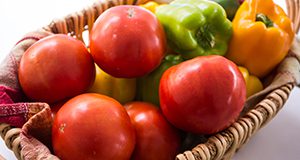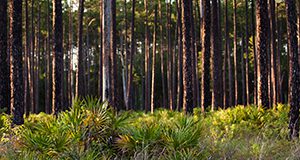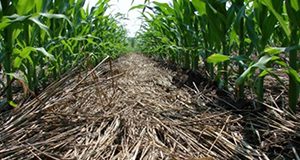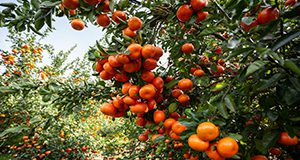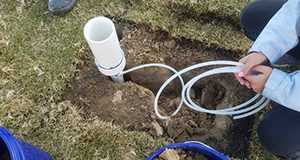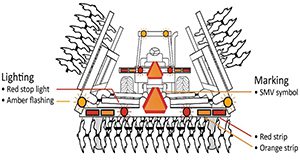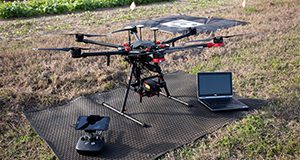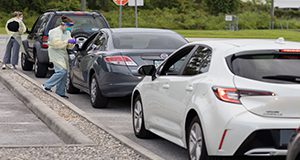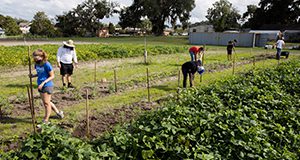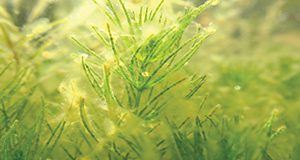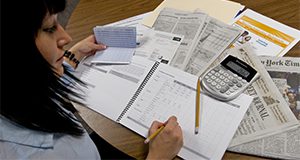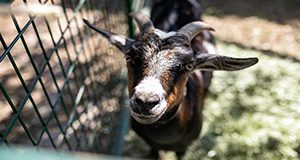Florida's K–12 schools provide a potential opportunity to increase market channel options for small- and mid-sized diversified farms, but processing, storage, and distribution resources are extremely limited for smaller producers. This 9-page document serves as a model and case study with steps for producers and other stakeholders to conduct a feasibility study before forming a cooperative to sell local fruits and vegetables to schools and other institutional food-service outlets. Written by Jonathan Adam Watson, Danielle D. Treadwell, Catherine Campbell, and Ray Bucklin, and published by the UF/IFAS Department of Agricultural and Biological Engineering, March 2021.
https://edis.ifas.ufl.edu/ae555
Author: Amanda Quintos
The Timber Value of an Existing Forest Stand
This 4-page publication presents a straightforward and intuitive approach based on compounding costs to determine the timber value of a forest at any stage of its development. Written by Andres Susaeta, and published by the UF/IFAS School of Forest, Fisheries, and Geomatics Sciences, March 2021.
https://edis.ifas.ufl.edu/fr435
Terminating Cover Crops Effectively for Weed Suppression
When utilizing cover crops for weed suppression, one important consideration is effective termination before planting the main crop. A major issue with improper termination is that the cover crop can become problematic and compete with the main crop, like other weeds. However, proper planning of the termination timing and method can minimize these issues and maximize the benefits of cover crop use. This 5-page publication discusses herbicide application, roller-crimper termination, tillage, and appropriate growth stages for termination. Written by Pratap Devkota, Michael J. Mulvaney, and David Wright, and published by the UF/IFAS Agronomy Department, February 2021.
https://edis.ifas.ufl.edu/ag449
Common Questions When Using Soil Moisture Sensors for Citrus and Other Fruit Trees
This guide is for Extension personnel who may encounter questions from growers about the functioning and accuracy of soil moisture sensors (SMSs) for fruit tree production. The 4-page publication focuses on two types of handheld sensors currently used in Florida for irrigation management of citrus and other trees: the transmission line oscillator (TLO) and time-domain transmissometer (TDT). Written by Eric Herrera, Sandra M. Guzmán, and Eduart Murcia, and published by the UF/IFAS Department of Agricultural and Biological Engineering, February 2021.
https://edis.ifas.ufl.edu/ae551
Design, Construction, and Installation of a Drainage Lysimeter for Use on Sandy, Well-Drained Soils under Turfgrass
Using lysimeters to collect water quality samples can provide a better understanding of nutrient or other solute migration below the surface, which can inform landscape management for environmental protection. This 6-page publication presents the materials, construction, installation, and management of a specific drainage lysimeter design in a step-by-step format. Written by Jovana Radovanovic, Eban Z. Bean, and Alexander J. Reisinger, and published by the UF/IFAS Department of Agricultural and Biological Engineering, February 2021.
https://edis.ifas.ufl.edu/ae554
Lighting and Marking of Agricultural Equipment on Highways: Summary of ASAE Standard S279.18
Agricultural vehicles on public roads can pose risks to their drivers and to drivers of other vehicles. Proper lighting and marking increase visibility of the farm equipment. This 6-page publication summarizes agricultural equipment lighting and marking standards. Written by Serap Gorucu, Charles Brown, and Carol Lehtola, and published by the UF/IFAS Department of Agricultural and Biological Engineering, revised February 2021.
https://edis.ifas.ufl.edu/ae175
Applications of Unmanned Aerial Systems in Agricultural Operation Management: Part III: Best Practices for Efficient Aerial Surveying
With the increasing use of unmanned aerial systems (UASs) in the agricultural domain, ensuring the consistency and completeness of aerial surveys is critical in order to establish repeatability and consistency in data collection activities. This publication covers five main steps to ensure that aerial data collections are repeatable and consistent among missions. It is one of a three-part series focusing on the applications, configuration, and best practices for using UASs in agricultural operations management. Written by Aditya Singh and James Fletcher, and published by the UF/IFAS Department of Agricultural and Biological Engineering, February 2021.
https://edis.ifas.ufl.edu/ae553
Applications of Unmanned Aerial Systems in Agricultural Operation Management: Part II: Platforms and Payloads
Unmanned aerial systems (UASs, UAVs, or drones) have emerged as an important tool for farmers, Extension agents, and landowners to map, monitor, and manage their properties. This 5-page publication provides an overview of the primary components of typical UASs to help growers, landowners, and/or Extension agents who want to configure and/or purchase a UAS or sensor system for agricultural operations. This document is one of a three-part series focusing on the applications, configuration, and best practices for using UASs in agricultural operations management. Written by Aditya Singh and James Fletcher, and published by the UF/IFAS Department of Agricultural and Biological Engineering, February 2021.
https://edis.ifas.ufl.edu/ae552
Purchasing Car Insurance: What College Students Should Know
Florida law requires drivers to have car insurance that provides financial protection in the event of a mishap. This 4-page publication provides an overview of auto insurance requirements in Florida as well as a glossary of car insurance terms for college students. Written by Nicholas Horvath, Jorge Ruiz-Menjivar, and Sarah M. Ellis, and published by the UF/IFAS Department of Family, Youth and Community Sciences, January 2021.
https://edis.ifas.ufl.edu/fy1493
Weed Management in Soybeans
Successful weed control is one of the most important practices for economical soybean production in Florida. This 10-page publication discusses weed control methods for soybean growers. Written by J. A. Ferrell, G. E. MacDonald, and P. Devkota, and published by the UF/IFAS Agronomy Department, revised January 2021.
https://edis.ifas.ufl.edu/wg010
Publicly Available Geographic Information Sources and Common Analysis Tools
Geographic information and geospatial data are vital in many practical fields, including precision agriculture, natural resources management, flood zone mapping and management, and environmental assessment. This 6-page publication introduces publicly available geospatial data, including elevation, land use, soil, satellite imagery, and other thematic maps and GIS software commonly used in spatial analysis. Written by Satbyeol Shin and Young Gu Her, and published by the UF/IFAS Department of Agricultural and Biological Engineering, January 2021.
https://edis.ifas.ufl.edu/ae550
Planning and Establishing On-Farm Field Trials
Planning and preparation can increase chances of successful outcomes from demonstration plots. This 5-page publication focuses on guiding the successful establishment of demonstration trials and is targeted to county, regional, and state specialized Extension faculty who aim to develop on-farm research and demonstration sites as part of their programs. Written by Marcelo Wallau, Esteban Rios, and Ann Blount, and published by the UF/IFAS Agronomy Department, January 2021.
https://edis.ifas.ufl.edu/ag447
The Ecology of Charophyte Algae (Charales)
Charophytes are a group of green algae within the order Charales. This 4-page publication provides an overview of charophyte ecology, habitat requirements, and status in the state of Florida. Written by Maximiliano Barbosa, Forrest Lefler, David E. Berthold, and H. Dail Laughinghouse IV, and published by the UF/IFAS Agronomy Department, January 2021.
https://edis.ifas.ufl.edu/ag448
The Genetics of Resistance to Gastrointestinal Parasites in Florida Native Sheep
This 3-page publication provides a brief overview of resistance to gastrointestinal nematode infections in Florida Native sheep. Written by Zaira M. Estrada Reyes, Owen Rae, Carol Postley, and Raluca G. Mateescu, and published by the UF/IFAS Department of Animal Sciences, August 2020.
https://edis.ifas.ufl.edu/an361
Fondos de Inversion: Un Glosario para Principiantes
El mejor momento para comenzar a invertir o ahorrar es ayer, ya sea para la jubilación, para enviar a su hijo o hija a la Universidad o para el pago inicial de una casa. Para poder tomar una decisión acertada sobre que vehículos financieros escoger para una cartera de inversiones o plan, es primero fundamental conocer las opciones disponibles en el mercado y entender los mecanismos y principios detrás de cada uno de estos vehículos de inversión. Hay libros enteros escritos sobre estos temas, pero con el propósito de este artículo es proporcionar un glosario breve, pero completo de los fondos principales de inversión financiera. This 3-page document is the Spanish version of FCS3352, Major Asset Classes: A Brief Glossary. Written by Jorge Ruiz-Menjivar, Nelly Nelson, and Jarrett Tsai, and published by the UF/IFAS Department of Family, Youth and Community Sciences, December 2020.
https://edis.ifas.ufl.edu/fy1494
Transitioning from Conventional to Organic Farming Using Conservation Tillage
Organic farming is one of the fastest-growing segments of the agricultural industry in the United States and in Florida. Conservation tillage is often employed to reduce soil erosion, improve physical and biological properties of soil, and increase water use efficiency. This 5-page article aims to provide recommendations to row crop farmers who wish to implement conservation tillage practices during their transition to a certified organic system. Written by D. L. Wright, J. Moyer, D. Treadwell, I. M. Small, and S. George, and published by the UF/IFAS Agronomy Department, revised November 2020.
https://edis.ifas.ufl.edu/ag246
Common Hazards Associated with Sheep and Goat Feed
This 7-page document provides a list of common hazards to consider in the manufacturing of feed for small ruminants. Written by Chalise Brown, Diwakar Vyas, and Jason M. Scheffler, and published by the UF/IFAS Department of Animal Sciences, November 2020.
https://edis.ifas.ufl.edu/an363
Gender Affirmation Surgery: Financial Considerations
This 3-page factsheet provides a brief overview of gender-affirming medical care, expenses, and funding options. A glossary with key terms discussed in this publication is included at the end. Written by Chloe W. Swearingen, Megan Donovan, Jorge Ruiz-Menjivar, and Sarah M. Ellis, and published by the UF/IFAS Department of Family, Youth and Community Sciences, November 2020.
https://edis.ifas.ufl.edu/fy1492
Crop Water Use and Irrigation Scheduling Guide for North Florida
Effective irrigation scheduling enables the irrigator to apply the right amount of water at the right time to meet the crop water demand. This 19-page guide presents information on average daily and weekly crop water use and crop growth stages for twelve north Florida crops that can be used to help schedule irrigation. This will allow a grower to develop a realistic irrigation schedule that minimizes plant water stress, saves water, and reduces nutrient leaching potential. Written by Vivek Sharma, Charles Barrett, De Broughton, and Thomas Obreza, and published by the UF/IFAS Department of Soil and Water Sciences, revised December 2020.
https://edis.ifas.ufl.edu/ss491
Boom Sprayer Calibration Tables
This 13-page publication is meant to make calibration of boom sprayers easier, and therefore more common, by providing a convenient chart that can be kept in barns, tractor cabs, sprayers, and mix-load facilities for quick reference. Written by Michael J. Mulvaney, Pratap Devkota, Ethan Carter, De Broughton, and Mark Mauldin, and published by the UF/IFAS Agronomy Department, November 2020.
https://edis.ifas.ufl.edu/ag446
